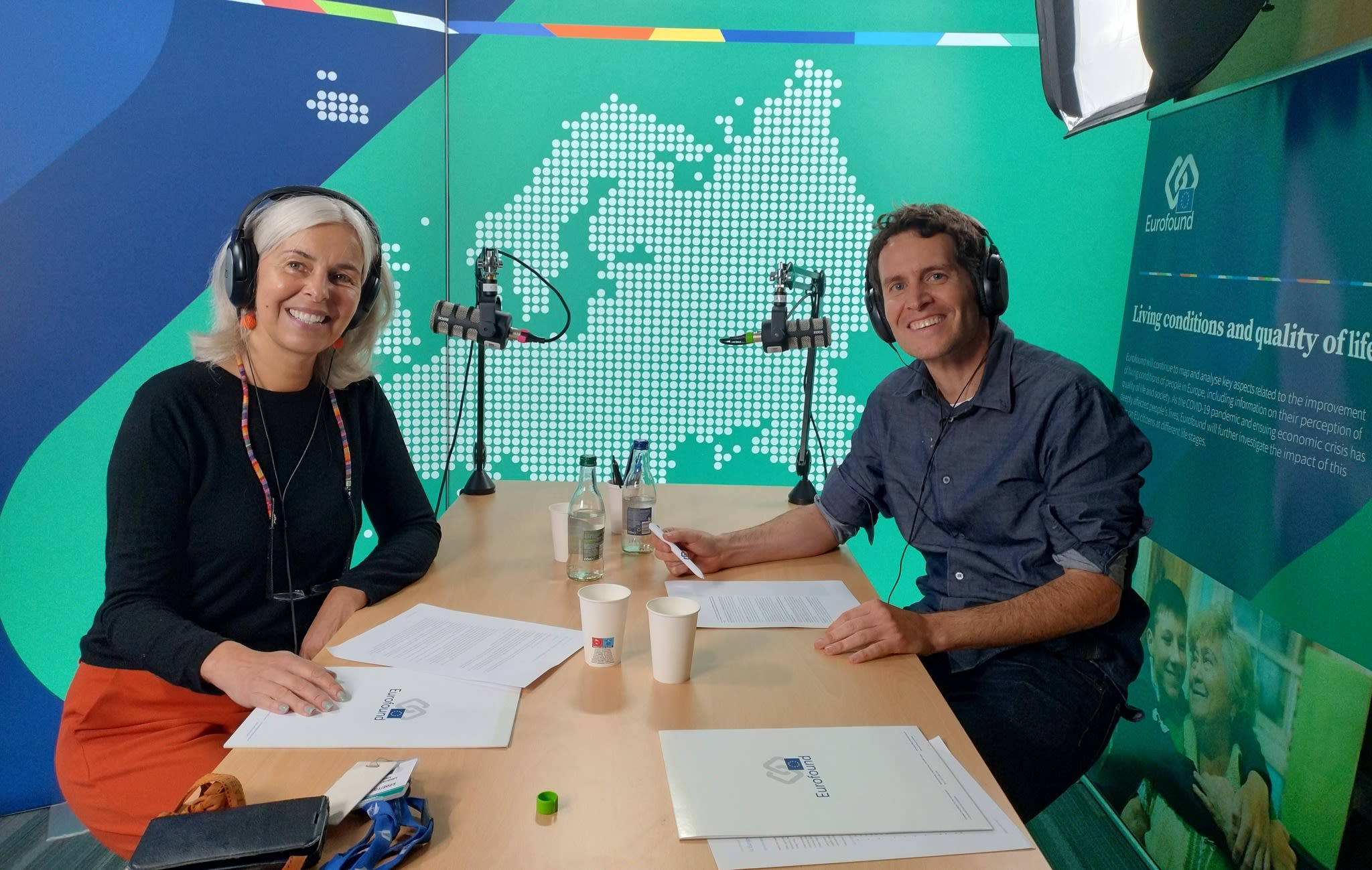Chapter 10:
Rising wages, persistent struggles
Europe in 2024: Are people better off?

Key insights
Inflation has slowed, but Europeans are still experiencing financial strain. Despite real wage growth, 30% of respondents to Eurofound’s e-survey struggle to make ends meet, and 15% report arrears on utility bills.
Income inequality trends vary across the EU. While EU-wide income inequality has declined over the past 15 years, it has risen in 13 countries, including Sweden and Bulgaria, and fallen in 14 countries, most significantly in Slovakia, Poland, Romania and Portugal.
Minimum wages are rising, but financial struggles remain. Despite improvements in real wage growth, 23% of minimum wage earners still report difficulties in making ends meet, 10 percentage points higher than other workers.
Single-person minimum wage households are particularly vulnerable. Across the EU, 28% of single-person minimum wage households struggle to make ends meet, double the average for all workers.
The middle class remains stable but is shrinking in many countries. Although 64% of EU citizens are middle class, this group is contracting in nearly two-thirds of Member States, particularly in Sweden, Luxembourg and Germany.
After years of economic upheaval, 2024 brought some signs of relief for workers in the EU, with inflation beginning to ease and nominal wages continuing to rise. Yet for millions of people across the EU, making ends meet remains a daily struggle. From soaring housing costs to unaffordable everyday essentials, the reality on the ground often paints a bleaker picture than the macroeconomic indicators suggest. The financial pressures once thought to primarily affect low-income groups are increasingly being felt by middle-income households.
There appears to be a disconnect between rising wages and the difficulties faced by certain people in making ends meet. Income inequality, despite some EU-wide convergence, is rising in several Member States. Minimum wages do not appear to be enough to shield all workers from poverty, particularly for those in single-person households.
Adequate minimum wages are a core element of the European Commission’s upcoming Anti-Poverty Strategy and the European Pillar of Social Rights, aimed at ensuring decent living standards and reducing in-work poverty. Eurofound’s findings contribute to assessing whether these goals are being met across Member States.
'For millions across the EU, making ends meet remains a daily struggle — despite rising wages and easing inflation.'

Income inequality returns to the spotlight

As Europe moves further away from the economic shocks of the Great Recession, the COVID-19 pandemic and the cost-of-living crisis, questions remain about whether living standards have truly improved. While headline economic indicators suggest recovery, financial strain remains a reality for many Europeans.
Income inequality has re-emerged as a significant concern in Europe. While public perception often suggests that income inequality is on the rise, recent research by Eurofound points to a more nuanced picture. Over the past 15 years, EU-wide income inequality has declined significantly, largely due to a strong process of income convergence driven by robust growth in the Member States that joined since 2004. However, at national level, the picture is more mixed.
Income inequality has increased in 13 countries, including Sweden, Denmark, Bulgaria and Malta, but declined in 14 countries, and quite significantly so in Slovakia, Poland, Romania and Portugal.
This 50–50 split indicates that once the lid is lifted on the general decline in inequality in the EU, different inequality dynamics are at play in individual countries. The extent to which Europeans feel better off in 2024 depends not just on economic growth, but also on how wealth and wages are distributed within countries.
Despite declining levels of income inequality, many people feel worse off. Inequality tells only part of the story – persistent inflation and affordability pressures are reshaping what it means to ‘get by’ in today’s Europe.

Cost-of-living pressures remain widespread

Households suffer from sustained inflation
Despite real increases in minimum wages in most EU Member States and a decline in headline inflation across the EU by 2024, cost-of-living pressures remain significant, particularly for low- and middle-income households.
In Eurofound’s 2024 Living and Working in the EU e-survey, 30% of respondents struggled to make ends meet, up from 22% in 2023. Additionally, 10% of respondents had missed rent or mortgage payments, while 15% reported arrears in utility bills – both figures reflecting increases from the previous year (Figure 34).
These rates reflect the increased challenges for households, despite improvements in macro-level economic indicators. Sustained inflation has depleted financial resilience, meaning that large numbers of people in the EU are struggling with everyday life. Women, particularly in middle-aged groups, and households in countries like Croatia, Estonia and Greece are among the most affected.
Figure 34: Proportion of respondents with cost-of-living difficulties, EU, 2022–2024 (%)
Unaffordable everyday expenses
As making ends meet became more difficult, more respondents in 2024 reported being unable to afford certain items or activities compared with 2023. The most common unaffordable expenses included new furniture, leisure activities, holidays, having a small amount of money to spend on oneself each week and getting together with family or friends at least once a month.
Among these, the largest increases in unaffordability were seen in leisure activities and holidays, particularly among middle-aged groups (35–49 and 50–64), who already had the highest proportion of people unable to afford these activities (Figure 35).
Figure 35: Inability to afford selected items or activities, by age group, EU, 2023–2024 (%)

Minimum wages: Key policy lever in uncertain times

As of 2024, 22 out of 27 Member States had a national minimum wage. Based on EU-SILC 2019 data, Eurofound previously estimated that around 4% of the EU’s working population earned around the minimum wage. More recent data from EU-SILC 2022 (referring to 2021 incomes) provides a more up-to-date basis for assessing minimum wage developments, although variations in national wage-setting systems and data availability continue to limit cross-country comparability. The recent period has also been shaped by major shocks such as the COVID-19 pandemic and the energy crisis, which have likely influenced both minimum wage coverage and relevance.
While implementation of the Minimum Wage Directive varies across Member States, the directive seems to have already influenced wage-setting processes. More countries are now referring to the reference values mentioned in the directive (such as 50% of the gross average wage or 60% of the median wage). This has contributed to notable increases in nominal minimum wage rates, improving the outlook for real wage growth.
The directive, one of the EU’s most significant pieces of social legislation, had a transposition date of 15 November 2024. Despite a recent opinion from the Advocate General recommending the annulment of the directive, the legal status of the directive remains unchanged.
Minimum wages rising across the EU
The national minimum wage nominal rates were subject to remarkable hikes in January 2024, almost to the same extent as in 2023 (Figure 36).
These increases, in several Member States, translated into real-term rises in purchasing power, due to lower inflation. When compared with January 2020, almost all countries now have higher national minimum wages in real terms, with the exceptions of France and Slovakia, where they remain at similar levels, and Czechia, the only country showing a decline.
Figure 36: Nominal changes to national minimum wages, January 2024 to January 2025, and annual inflation, selected Member States, December 2023 to December 2024 (%)
The reality behind rising minimum wages
Minimum wage earners have more difficulties in making ends meet. Among all minimum wage earners, 23% reported difficulties in making ends meet in 2022 on average across EU Member States, which is 10 percentage points higher than for other workers (Figure 37). Additionally, 10% of minimum wage workers in the EU reported difficulties keeping their homes adequately warm (compared with 6% of others).
While only 22 of the EU’s 27 Member States have a statutory national minimum wage, this section refers to all 27 Member States. In the remaining countries – such as Denmark, Sweden, Finland, Italy, and Austria – minimum wages are typically set through sectoral collective agreements with high worker coverage, allowing for meaningful comparison.
While the extent of these difficulties varies across EU Member States, minimum wage earners in Greece experience the highest financial strain, with 80% reporting challenges in making ends meet. Other countries where minimum wage earners face heightened financial pressure include Cyprus, Bulgaria, Croatia, Hungary, Latvia, Portugal and Romania.
In contrast, minimum wage workers in Germany, Sweden, Denmark, the Netherlands and Finland are less likely to experience financial hardship. However, minimum wage earners are more affected by such financial difficulties than other employees earning above minimum wage levels in all EU Member States except Malta.
Figure 37: Difficulties in making ends meet among minimum wage earners, EU Member States, 2021–2022 (%)
Living alone on the minimum wage
Minimum wage earners in single-person households are particularly vulnerable. Some 28% of single-person minimum wage households struggle to make ends meet – double the average (14%) across all workers (Figure 38).
The notable cross-country disparities seem related to average income levels: the share of minimum wage earners in single-person households facing difficulties in making ends meet is highest (above 30%) in several countries characterised by relatively low income levels – particularly in Member States that joined the EU after 2004 and Mediterranean countries. It is lowest (below 10%) in several higher-income countries that were EU members before the 2004 enlargement.
Figure 38: Difficulties making ends meet, minimum wage and other workers compared, EU Member States, 2022 (%)
Is Europe’s middle class disappearing?
Financial pressure is not limited to those on the lowest incomes. Middle-income families – once considered relatively secure – are also feeling the squeeze.
The general perception seems to be that the middle class, defined as households earning between 75% and 200% of the national median income, is shrinking. Eurofound data rule this out, finding that on average, around 64% of people across the EU Member States belong to the middle class. This proportion remained more or less stable between 2006 and 2022.
However, when we dig down to country-level data for that period, it can be seen that the middle class shrank in almost two-thirds of Member States, albeit to varying degrees. The contraction was more significant in a mix of pre-2004 Member States (especially Sweden and Luxembourg, and also the Netherlands, Germany, Austria and Denmark) and post-2004 Member States (especially Bulgaria and Malta, and also Lithuania, Czechia, Hungary and Estonia). Conversely, the middle class expanded in 10 countries, and to a very significant extent in some of the central and eastern European countries, such as Romania, Poland and Croatia, as well as Portugal and Ireland.
The middle-class squeeze
The cost-of-living crisis clearly has had an impact. Other factors that have widened income inequality – and the squeeze on the middle class – are the weakening of income redistribution at the family level, largely due to a decline in average household size, and the widening of wage disparities in labour markets, which has occurred in about half of the countries.
Conversely, the two main factors that have tended to reduce income inequality (and increase the size of the middle class) are the higher employment and activity rates in most countries and the robust income redistribution measures carried out by welfare states in more than half of EU Member States.
The welfare state in particular has a strong impact in moderating income inequality, reducing it by an average of around 42% across Member States once social benefits and taxes are taken into account. This was particularly evident during the COVID-19 pandemic when widespread job retention schemes helped prevent a sharper decline in household incomes.
Discover more
- Report: Minimum wages in 2024: Annual review
- Report: Developments in income inequality and the middle class in the EU
- Article: Towards adequate minimum wages: Fairness and a decent standard of living
- Article: A snapshot of income inequality and middle class across the EU
- Eurofound Talks: Is Europe’s middle class disappearing?
- Eurofound Talks: Are minimum wages in Europe adequate and effective?
